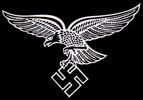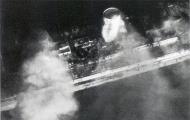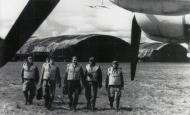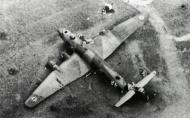Focke-Wulf Fw 200C Condor 7./KG40 Bordeaux 1943 01
Photo 01: Focke-Wulf Fw 200C3 Condor of Seen in the background is a Fw 200C-5 of 7./KG 40 at Bordeaux in 1943. The C-5 variant was a long-range reconnaissance version of the Condor. Note the Lotfe 7D bombsight in the aircraft in the foreground and the Ju-88C-6s on the left.
Focke-Wulf Fw 200C Condor 7./KG40 Bordeaux 1943 02
Photo 02: Six unidentified crew from 7./KG 40 stroll towards their Condor. Four of the visible crew are wearing the K So/34 one-piece flight suits with the kapok-filled Schwimmweste 10-76. The pilot is probably the individual in the middle wearing the uniform breeches. All with the exception of the pilot are wearing a mixture of LKp S 100 and LKp N 101 flying helmets with Nitsche & Gunther flying goggles. Note the FuG Rostock search radar just visible on the nose of the aircraft.
7./KG40 attack on the liner Duchess of York 01-02
Photo 01-02: Result of an attack by 7./KG 40 on 11 July 1943. The photographs show the burning liner Duchess of York, attacked by Oblt Ludwig Progner, Hptm Helmut Liman and Oblt Egan Scherret.
The convoy had been detected by the Luftwaffe and three Condors from 7./KG40 commanded by Hptm Helmut Liman, Oblt Ludwig Progner and Oblt Egon Scherret had been sent to investigate. At 2010 hrs they commenced their attacks, each aircraft dropping four 250 kg bombs from high altitude and with extreme accuracy. Pit Off Peter Dyson was a passenger on the Duchess of York:
“There was a series of explosions, all the lights went out and the mirrors shattered. I was unhurt and soon scrambled up and out onto the promenade deck, to see the ship ablaze from amidships to the stern. We had been hit by a string of three bombs dropped by Condors. Both the other ships were also ablaze, the convoy had been wiped out. We discovered years later that we were off the coast of Portugal and thought to be out of range of the Condors, but it was supposed that these had been based in ‘neutral' Spain, though whether that was actually so I never heard. The other troopship was the California, many of the passengers on which were civilians, including a lot of young Irish nuns bound for missions in Africa. After the war I discovered that an old school friend was killed on the California, he was in the colonial service. The third ship was a "fast cargo-liner" and she survived, the fires were extinguished and a destroyer towed her into Casablanca a few days later.
Although I have forgotten many of the details of my service life, the events of the next few weeks are as clear as ever and I could write many pages about them. Briefly, I was picked up by a lifeboat and transferred via scrambling nets to a Royal Navy frigate which picked up several hundred survivors. After two days we docked at Casablanca and we survivors were taken over by the US army and housed in a tented transit camp.”
The convoy responded with a heavy barrage of anti-aircraft fire but the Duchess of York was immediately enveloped in flames. The California then had a near miss which tore a 100 ft long hole in her starboard side above the waterline. Soon afterwards the California was attacked a second time, being hit by two bombs, one of which hit in No 2 hold and the other between the funnel and the bridge; a third bomb went into the sea but blew a hole in the starboard side in the vicinity of No 7 hold.
According to the Captain's report, the California's engines were undamaged in the attack but the steering gear was put out of action and all communication with the bridge was lost except for the engine room telegraph. However, the real threat was from fire for, as he reported, "the whole vessel appeared to be blazing". After the second hit, he ordered the engines to be stopped and the boats lowered. Though at first it was hoped that it might still be possible to save the ship, the fire and heat were so terrific that it was obvious that the situation was hopeless and the order to abandon ship was given. Of 30 lifeboats on the ship, 17 got away safely as well as a number of rafts. 45 crew and 21 passengers were eventually reported missing and one man subsequently died in hospital. It was a similar story on the Duchess of York: 27 passengers and crew lost their lives.
The attack, from just under 5,000 metres, was a spectacular success, lasting a little less than 30 minutes during which time six attacking runs were made and 14 bombs were said to have been dropped - 4 were direct hits and 10 were near misses. The hulk of the Duchess of York was still afloat the following morning and was photographed by the Condor commanded by Hptm Paul Husslein of III./KG 40 who was possibly responsible for damaging the only surviving ship from the convoy, the Port Fairy, that same day.
7./KG40 Fw 200C combat kill a 295 Squadron Halifax 01
Photo 01: A rare air combat kill for a Condor. A 295 Squadron Halifax shot down by Hptm Georg Schabert of 7./KG 40, on 14 June 1943; there were no survivors.
Focke-Wulf Fw 200C Condor 7./KG40 (F8ER) shot down 1943 01
Death of a Condor. Last moments of Fw 200C-4, WNr. 0186, coded F8+ER of 7./KG 40 as it is shot down by four Beaufighters of 248 Squadron over the Atlantic on 12 March 1943. None of Lt Ernst Rabolt's crew survived. The Condor was extremely vunerable to fighter attack due to its lack of armour and the fact that all its fuel lines were on the underside of the aircraft.
7. Staffel III. Gruppe Kampfgeschwader 40 - 7./KG 40
Focke-Wulf Fw 200C Condor 7./KG40 (F8AR) crew 01
Photo 01: Focke-Wulf Fw 200C8 Condor of 7./KG40, WNr. 0248, coded F8+AR. This aircraft would be lost on 5 March 1944 when it was shot down by aircraft of the US 4th and 357th Fighter Groups near St Jean D'Angeley whilst Hptm Georg Schabert (4th from left) and his crew were lost over the Atlantic on 29 December 1943 in another aircraft.
Focke-Wulf Fw 200C Condor 7./KG40 Bordeaux 1943 01
Photo 01: Focke-Wulf Fw 200C3 Condor of Seen in the background is a Fw 200C-5 of 7./KG 40 at Bordeaux in 1943. The C-5 variant was a long-range reconnaissance version of the Condor. Note the Lotfe 7D bombsight in the aircraft in the foreground and the Ju 88 C-6s on the left.
Focke-Wulf Fw 200C Condor 7./KG40 Bordeaux 1943 02
Photo 02: Six unidentified crew from 7./KG 40 stroll towards their Condor. Four of the visible crew are wearing the K So/34 one-piece flight suits with the kapok-filled Schwimmweste 10-76. The pilot is probably the individual in the middle wearing the uniform breeches. All with the exception of the pilot are wearing a mixture of LKp S 100 and LKp N 101 flying helmets with Nitsche & Gunther flying goggles. Note the FuG Rostock search radar just visible on the nose of the aircraft.
Focke-Wulf Fw 200C Condor attacking Allied Merchant Shipping 01-02
Photo's 01-02: These two pictures show various Merchant shipping being attacked by unknown Fw 200C Condor's.
Focke-Wulf Fw 200C Condor 7./KG40 (F8BR) Bordeaux 1942 00
Profile 00: Focke-Wulf Fw 200C3 Condor of 7./KG40, WNr.0063 after repair but was later lost after it had to ditched in Storsdahlfjord on 22 February 1942 due to engine failure. Oberleutnant Karl Thiede and the crew were rescued.
Focke-Wulf Fw 200C Condor 7./KG40 (F8BR) Bordeaux 1942 01
Photo 01: Focke-Wulf Fw 200 C-3 Condor of 7./KG40, WNr.0063 after repair but was later lost after it had to ditched in Storsdahlfjord on 22 February 1942 due to engine failure. Oberleutnant Karl Thiede and the crew were rescued.
Focke-Wulf Fw 200C Condor 7./KG40 (F8BR) Bordeaux 1942 02
Focke-Wulf Fw 200C Condor 7./KG40 (F8CR) loaded with oxygen 01
Photo 01: Focke-Wulf Fw 200C3 Condor of 7./KG40, (F8+CR) being loaded by two mechanics who carry a cylinder, used to top up the on-board oxygen supply, towards a Fw-200 of 7./KG 40. This Condor carries the splinter pattern of RLM 72 and 73 with the code F8+CR in black with the aircraft letter' C' edged in white. On many Fw-200s the fuselage Balkenkreuz had narrow white outlines.
Focke-Wulf Fw 200C Condor 7./KG40 (F8FR) Norway 1945 0A-0D
Profiles 0A-0C: Focke-Wulf Fw 200C-8 Condor of code F8+FR. The aircraft was finished in the standard upper maritime colors of 72 and 73. However, along the sides of the fuselage, fin and, engine cowlings, this was later adapted by the application of a randomly applied mottle, heavy in places, of a light color such as white or pale grey, presumably for operations over northern waters. As shown in the accompanying photographs, this pale color did not extend to the tops of the flying surfaces. The fuselage codes are black with the aircraft letter T possibly outlined in the Staffel color of yellow. Uncommonly for the type, the F8 unit code has been applied in the small, mid-1943 style. When this aircraft was found by the Allies in Norway, it had been exposed to the external elements for several months. This would account for the severe weathering of the white paintwork, which especially on the uppersurfaces, was beginning to show the original camouflage underneath. The unit code F8 in front of the Balkenkreuz was painted in black approximately one-sixth of the standard letter height. The Staffel letter 'R' and individual aircraft letter 'F' were also in black with the latter being thinly outlined in white. Some trouble had been taken to paint around the national markings.
Focke-Wulf Fw 200C Condor 7./KG40 (F8FR) Norway 1945 01-04
Photos 01-04: It is unusual to find photographs of both sides of an operational example of a Focke-Wulf Fw-200. These two photographs give port and starboard side views of Fw 200C-8, FB+FR of the 7./KG 40 which was captured in Norway in 1945 and is the subject of the colour profile below. This Fw 200C-8 was found abandoned in Norway at the end of the war. It carried the code FS+FR. The aircraft originally had been painted in the factory camouflage pattern of RLM 72/73 on the upper surfaces with RLM 65 underneath. During the winter of 1944/45, snow camouflage had been crudely applied by spraying temporary thin white paint over the aircraft upper and side surfaces. The intensity of the spray application is clearly seen in the photograph of the close-up of the cockpit.
Focke-Wulf Fw 200C Condor 7./KG40 (F8MR) Norway 1945 01-04
Focke-Wulf Fw 200C Condor 7./KG40 Bordeaux 1943 01-02
Photo 01: Focke-Wulf Fw 200C3 Condor of Seen in the background is a Fw 200C-5 of 7./KG 40 at Bordeaux in 1943. The C-5 variant was a long-range reconnaissance version of the Condor. Note the Lotfe 7D bombsight in the aircraft in the foreground and the Ju-88C-6s on the left.
Photo 02: Six unidentified crew from 7./KG 40 stroll towards their Condor. Four of the visible crew are wearing the K So/34 one-piece flight suits with the kapok-filled Schwimmweste 10-76. The pilot is probably the individual in the middle wearing the uniform breeches. All with the exception of the pilot are wearing a mixture of LKp S 100 and LKp N 101 flying helmets with Nitsche & Gunther flying goggles. Note the FuG Rostock search radar just visible on the nose of the aircraft.
8. Staffel III. Gruppe Kampfgeschwader 40 - 8./KG 40
Focke-Wulf Fw 200C Condor 8./KG40 (F8CS) 1941 0A-0B
Profile 00: Focke-Wulf FW-200C-4/U3 W.Nr.0175 F8+AS at San Pablo airfield, Seville, Spain not long after its landing. Notice the shape of the with Balkenkreuz on this aircraft.
Focke-Wulf Fw 200C Condor 8./KG40 (F8AS) Seville Spain 01
Photo 01: Focke-Wulf FW-200C-4/U3 W.Nr.0175 F8+AS at San Pablo airfield, Seville, Spain not long after its landing. Notice the shape of the with Balkenkreuz on this aircraft.
Focke-Wulf Fw 200C Condor 8./KG40 (F8CS) Kemi, Finland 1941 0A-0B
Profile 0A-0B: Focke-Wulf Fw 200C-1 of 8./KG 40, August 1941. Around this time III./KG 40 began to exchange its He-111s for Fw-200s. One of the most unusual features of KG 40's Fw 200s was the painting of oversize black areas to the fuselage Balkenkreuz. The Staffel operated the Condor until March 1943 when it began to re-equip with the He 177 at Fassberg. The aircraft is finished in the subtly different uppersurface colours of dark greens 72 and 73.
Focke-Wulf Fw 200C Condor 8./KG40 (F8CS) Kemi, Finland 1944 01
Photo 01: Focke-Wulf Fw 200C-1 with all four engines running, an Fw-200 prepares for take-off from its home base at Bordeaux-Merignac. This aircraft, coded F8+CS of 8./KG40, has its individual letter 'C' outlined in red and has red tips to its spinners. The III. Gruppe of the Geschwader did not begin to receive the type until early 1942, but even at that time, a large proportion of the unit's Focke-Wulfs had a modified version of the old style fuselage Balkenkreuz with narrow white outlines.
Focke-Wulf Fw 200C Condor 8./KG40 (F8CS) Kemi, Finland 1942 02
Photo 02: Focke-Wulf Fw 200 C-4 though a C-4 variant seen in 1942, this view of the underside of the fuselage and the ventral gondola of Focke-Wulf Fw-200 Condor coded KE+IY later F8+CS of 8./KG40 nevertheless gives an excellent impression of how the ground crews had to repaint the panel joints of the aircraft in new pale blue paint due to wear caused by exposure to the elements. Note the WNr. 0100 is painted in black forward of the gondola and the Lotfe bombsite housing is clearly visible. This aircraft subsequently suffered 50 per cent damage in an accident on 9 November 1940.
Focke-Wulf Fw 200C Condor 8./KG40 (F8CS) 1944 01-02
Photos 03-04: An Fw-200 C-4 of KG 40 with all four BMW Bramo radial engines running 'sits' on its wheel chocks, possibly on an engine test by ground crew - note the open cockpit roof hatch. Apart from the HOL 151 (cannon armed) upper turret, either a 13 mm MG 131 or a 20 mm MG 151 was mounted in the nose of the ventral gondola, depending upon whether the Lofte 70 bomb sight was carried. Due in this instance to the bombsight being installed, a MG 131 is carried. All other defensive positions mounted 7.9 mm machine guns.
Focke-Wulf Fw 200C Condor 8./KG40 (F8HS) France 01
Photo 01: Said to be a Focke-Wulf FW-200C-4 Condor WNr. 0118, coded F8+HS of 8./KG 40. It is shown here taking off at its French base. Of some interest is the retracted tail wheel, most pictures of Condors on operations show them non retracted.
Focke-Wulf Fw 200C Condor 8./KG40 (F8LS) 1943 0A-0B
Profile 0A: Focke-Wulf FW-200C-4/U3 F8+LS. Letter L in black with yellow outline with spinner tips.
Profile 0B: Focke-Wulf FW-200C-4/U3 F8+LS. Letter L in red with white outline with red spinner tips.
Focke-Wulf Fw 200C Condor 8./KG40 (F8MS) Norway 0A
Focke-Wulf Fw 200C Condor 8./KG40 (F8MS) Sweden 1945 01
Profile 0A and Photo 01: Focke-Wulf FW-200C-3 Condor coded F8+MS of 8./KG 40 was originally based in Oslo Norway. This aircraft along with its crew defected to Torslanda, Sweden on the May 8th 1945. Smart chaps!
9. Staffel III. Gruppe Kampfgeschwader 40 - 9./KG 40
Fw 200C Condor 9./KG40 crash-landed Spain 1943 01-02
Photo 01-02: On 13 August 1943 Fw 200C-5/U1, WNr. 0221 of 9./KG 40 was damaged in combat with a B-24 Liberator of the 1st Squadron/480th Anti-Submarine Group (captained by Lt F W McKinnon) and force-landed at Camarinas in Spain. Oblt Gunther Seide and his crew were quickly repatriated. Note the shadow of the Liberator on the ground in the picture above, clearly showing its belly-mounted AN/APS 15 search radar.
Such successes were few and far between as Uffz Werner Zerrahn of 9./KG 40 recalls:
"13 August 1943: In almost all cases, we had been briefed to fly an armed reconnaissance sortie over the Bay of Biscay as far as to the Azores. Flights like this had a duration of about 10 - 12 hours and our aircraft carried four 250 kg bombs and later two Henschel Hs 293A radio controlled missiles.
During our approach, we were able to make out a convoy and reported its position to Bordeaux by sending a coded radio message. Only a few minutes later, a B-24 Liberator appeared which caused a lot of trouble. The enemy's speed was considerably higher than ours and we received many hits. Our gunner Obgefr Heinz Wagner was wounded and holes in the fuel tanks caused the loss of quite an amount of fuel. Fortunately, we reached a layer of cloud and with the last drop of fuel we were able to make a good belly-landing in a harvested field of maize near La Coruna in Spain. After spending a few days in La Coruna and Valladolid, we came to Madrid and two weeks later, we arrived back at Bordeaux."
Focke-Wulf Fw 200C Condor 9./KG40 (F8OT) Mediterranean 01
Photo 01: Focke-Wulf Fw 200C-3 coded F8+OT of 9/KG 40 undergoing a tyre change. This Mediterranean based aircraft carries the white fuselage band. Also notice the different Balkenkreuz shape.
Focke-Wulf Fw 200C Condor 9./KG40 (F8CT) North Africa 1942 01
Photo 01: 9./KG 40, as a change to its normal anti-shipping duties, began re-supply duties in North Africa, late in 1942. Seen here are (left) Fw Walter Spendrath (killed 18 July 1944) and Uffz Otto Kipp. Photo 02: Three flight crew of 9./KG 40 pause for a moment during unloading operations during the unit's re-supply missions to North Africa in 1942. The crew are from left to right: Uffz Karl Nothelfer (killed 27 January 1944), Uffz Siegfried Hoffmann and Uffz Otto Kipp.
Focke-Wulf Fw 200C Condor 9./KG40 (F8GT) 1942 01
Photo 01: Focke-Wulf Fw 200C-4 long-range reconnaissance and bomber aircraft of III/KG40 coded F8+GT of 9./KG 40, is seen here in 1942. The individual aircraft letter 'G' was black outlined in yellow.
Focke-Wulf Fw 200C Condor 9./KG40 North Africa 1942 01
Photo 01: 9./KG 40, as a change to its normal anti-shipping duties, began re-supply duties in North Africa, late in 1942. Seen here are (left) Fw Walter Spendrath (killed 18 July 1944) and Uffz Otto Kipp.
Focke-Wulf Fw 200C Condor 9./KG40 (F8HT) Kemi 1944 01-02
Photos 01-02: Focke-Wulf Fw 200 C-8 long-range reconnaissance and bomber aircraft of III/KG40 coded F8+HT at Kemi in autumn 1944. (Bottom) The KG 40 globe insignia on the nose of an FW 200 Condor.
Focke-Wulf Fw 200C Condor 9./KG40 North Africa 1942 01
Photo 01: 9./KG 40, as a change to its normal anti-shipping duties, began re-supply duties in North Africa, late in 1942. Seen here are (left) Fw Walter Spendrath (killed 18 July 1944) and Uffz Otto Kipp.
Focke-Wulf Fw 200C Condor 9./KG40 (F8NT) in flight 1943 01
Photo 01: Fw 200C-5, W.Nr. 0214, coded F8+NT of 9/KG 40 was lost on 23 August 1943 when it was forced to ditch. Ofw Alfred Billing and five crew, were rescued, but one crewman was lost, Ofw. Hans Gentsch, the flight engineer. Note the fins of the two bombs in the outboard position under the starboard wing.

Karl Thiede
Units: 3/KG-40 (6/41), 7/KG-40 (10/41)
Awards: Bomber (or Observer) Operational Clasp
Known Aircraft: Fw 200C-3 WNr 0063 'F8+CL' (lost)
Remarks: Shot down by D/S Duoro and made a force landing in a Norwegian Fjord, near Färöyn Island, by Trondheim Norway on 22 February, 1942 with a crew of Uffz Wilhelm Degand (co-pilot), StabsFw Jakob Weber (1st R/O), Ogefr Johann Baier (2nd R/O), Uffz Heinz Kirsch (gunner) and Fw Paul Maertins (flt engr). Pilot and crew did not survive the watery crash. The AC sank but is reported recovered in a Jager Blatt article 3/1999. SIG (Special Interest Group) Norway information suggests that the Fw 200 was Werk # 0087 'F8+FR', and that the date was . The crew names are the same in both reports.
Bordeaux-Mérignac Airport, Mérignac, France Map
Kemi, Finland Map
Book References: +
- Gunston, Bill. The Illustrated Encyclopedia of Combat Aircraft of World War II, Salamander Books, London, 1977.
- Kay, Anthony L and Smith, J R. German Aircraft of the Second World War, Putnam, London, 2002 (Rev Ed).
- Mondey, David. The Hamlyn Concise Guide to Axis Aircraft of World War II, Bounty Books, London, 2006.
Magazine References: +
- Airfix Magazines (English) - http://www.airfix.com/
- Avions (French) - http://www.aerostories.org/~aerobiblio/rubrique10.html
- FlyPast (English) - http://www.flypast.com/
- Flugzeug Publikations GmbH (German) - http://vdmedien.com/flugzeug-publikations-gmbh-hersteller_verlag-vdm-heinz-nickel-33.html
- Flugzeug Classic (German) - http://www.flugzeugclassic.de/
- Klassiker (German) - http://shop.flugrevue.de/abo/klassiker-der-luftfahrt
- Le Fana de L'Aviation (French) - http://boutique.editions-lariviere.fr/site/abonnement-le-fana-de-l-aviation-626-4-6.html
- Le Fana de L'Aviation (French) - http://www.pdfmagazines.org/tags/Le+Fana+De+L+Aviation/
- Osprey (English) - http://www.ospreypublishing.com/
- Revi Magazines (Czech) - http://www.revi.cz/
Web References: +
- Wikipedia.org - http://en.wikipedia.org/wiki/Heinkel_He_219
 Editor for Asisbiz: Matthew Laird Acred
Send Mail
Editor for Asisbiz: Matthew Laird Acred
Send Mail
Please help us to improve these articles with any additional information or photo's.
If you should encounter any bugs broken links, or display errors just email us.
If you love our website please add a like on facebook or follow us on Google+
Please donate so we can make this site even better !!

-Bordeaux-1942-00.jpg)
-Norway-1944-0B.jpg)
-Norway-1945-0A.jpg)
-Norway-1945-0C.jpg)
-Norway-1945-0D.jpg)
-Norway-1944.jpg)
-Seville-Spain-00.jpg)
-1941-0A.jpg)
-1941-0B.jpg)
-1943-0A.jpg)
-1943-0B.jpg)
-Norway-0A.jpg)
.jpg)
-on-patrol-01.jpg)
-Bordeaux-1941-01.jpg)
-crew-01.jpg)
-Bordeaux-1942-01.jpg)
-Bordeaux-1942-02.jpg)
-loaded-with-oxygen-01.jpg)
-shot-down-1943-01.jpg)
-Norway-1944-01.jpg)
-Norway-1944-02.jpg)
-Norway-1944-03.jpg)
-Norway-1944-04.jpg)





-Seville-Spain-01.jpg)
-1941-01.jpg)
-1941-02.jpg)
-1944-01.jpg)
-1944-02.jpg)
-France-01.jpg)
-Sweden-1945-01.jpg)
-Sweden-1945-02.jpg)
-North-Africa-1942-01.jpg)
-North-Africa-1942-02.jpg)
-1942-01.jpg)
-Kemi-1944-01.jpg)
-Kemi-1944-02.jpg)
-in-flight-1943-01.jpg)
-Mediterranean-01.jpg)


-Norway-1944.bmp)
-Norway-1944-ANC.bmp)
-Norway-1944-NM.bmp)
-Norway-1944-SNM.bmp)
-Gotenhafen-1944.bmp)
-Gotenhafen-1944-NC.bmp)
-Gotenhafen-1944-NM.bmp)
-Gotenhafen-1944-V0A.jpg)
-Norway-1944.bmp)
-Norway-1944-NM.bmp)
-Norway-1944-V0A.jpg)
-Seville-Spain.bmp)
-Seville-Spain-NC.bmp)
-Seville-Spain-NM.bmp)
-Seville-Spain-V0A.jpg)